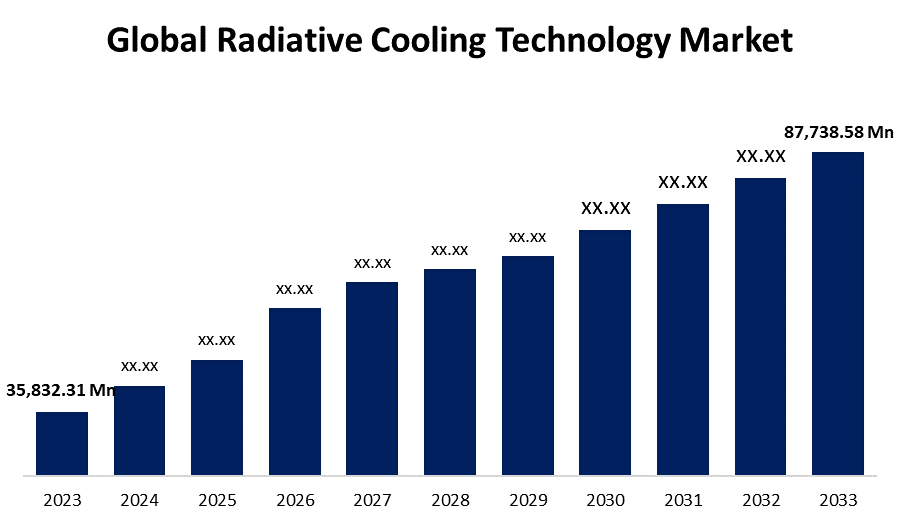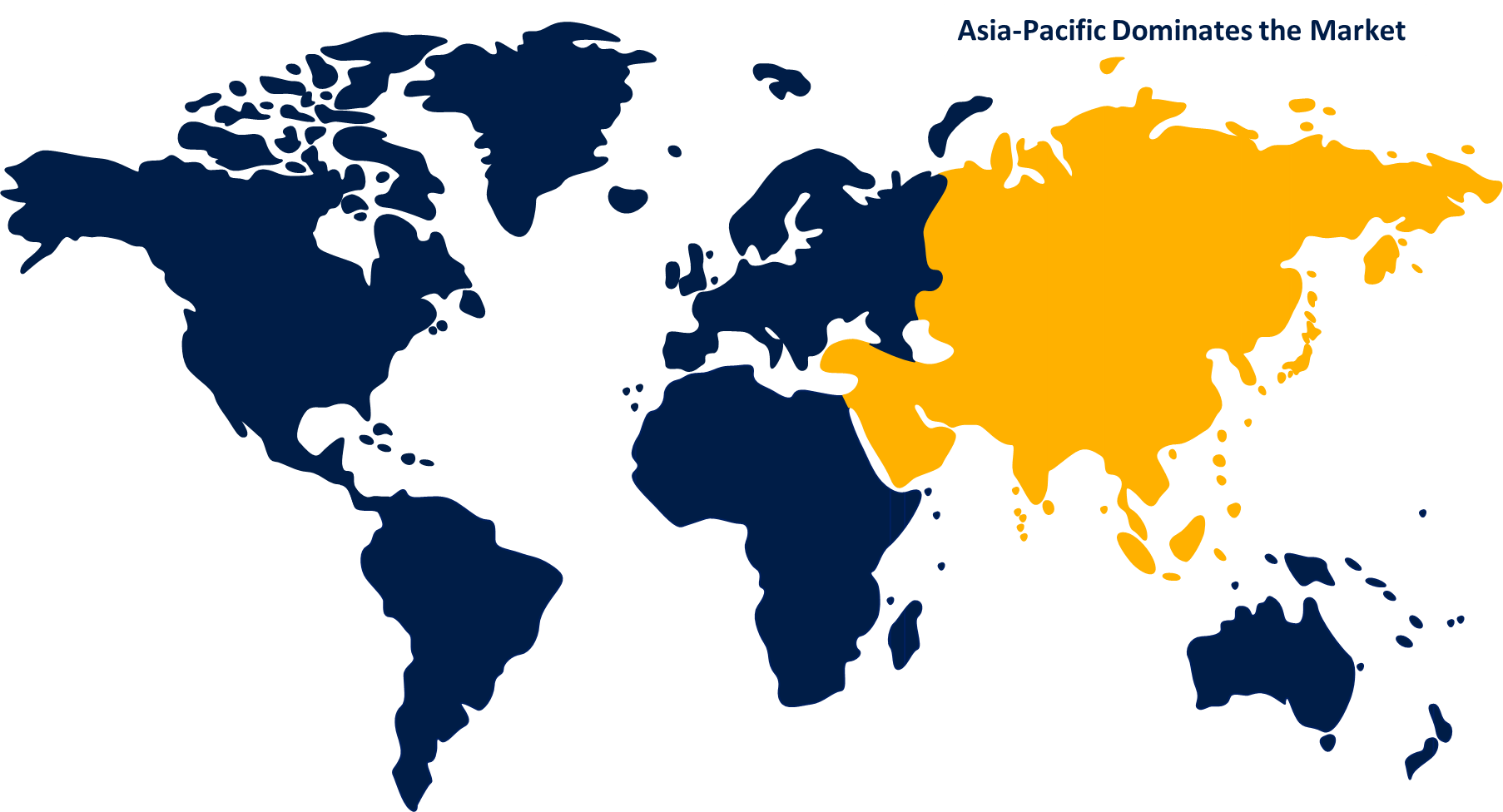Global Radiative Cooling Technology Market Size, Share, and COVID-19 Impact Analysis, By Material Type (Coating, Films, Paints, Ceramics, Textile, and Others), By Application (Building Cooling, Outdoor Cooling, Power Generation, Electricity Generation, Electrical Cooling, HVAC, Cold Harvesting & Storage, and Others), By End Use Industry (Residential, Commercial, Industrial, and Educational), and By Region (North America, Europe, Asia-Pacific, Latin America, Middle East, and Africa), Analysis and Forecast 2023 - 2033
Industry: Semiconductors & ElectronicsGlobal Radiative Cooling Technology Market Insights Forecasts to 2033
- The Global Radiative Cooling Technology Market Size was Valued at USD 35,832.31 Million in 2023
- The Market Size is Growing at a CAGR of 9.37% from 2023 to 2033
- The Worldwide Radiative Cooling Technology Market Size is Expected to Reach USD 87,738.58 Million by 2033
- North America is Expected to Grow the fastest during the forecast period.

Get more details on this report -
The Global Radiative Cooling Technology Market Size is Anticipated to Exceed USD 87,738.58 Million by 2033, Growing at a CAGR of 9.37% from 2023 to 2033.
Market Overview
Radiative cooling technology is a passive cooling method wherein a surface emits infrared radiation into cold space, usually through a specific atmospheric window with a wavelength of 8-13 μm. This technique uses natural thermal radiation instead of energy or active mechanical components to cool surfaces, even in direct sunlight. The fundamental idea behind radiative cooling is the idea that all objects emit heat radiation based on their temperature. This radiation is primarily infrared. By releasing this radiation selectively at specific wavelengths, particularly in the atmospheric window where radiation can escape freely into space, it is possible to increase the cooling impact. Certain spectral bands in the Earth's atmosphere, known as the atmospheric window, allow infrared radiation to escape into space. By releasing heat into space, objects can efficiently cool down by producing thermal radiation in these bands, which are typically between 8 and 13 micrometers. Radiative cooling technology is expanding due in large part to consumer demand for energy-efficient cooling solutions.
Report Coverage
This research report categorizes the market for the global radiative cooling technology market based on various segments and regions forecasts revenue growth and analyzes trends in each submarket. The report analyses the key growth drivers, opportunities, and challenges influencing the global radiative cooling technology market. Recent market developments and competitive strategies such as expansion, product launch, and development, partnership, merger, and acquisition have been included to draw the competitive landscape in the market. The report strategically identifies and profiles the key market players and analyses their core competencies in each sub-segment of the global radiative cooling technology market.
Global Radiative Cooling Technology Market Report Coverage
| Report Coverage | Details |
|---|---|
| Base Year: | 2023 |
| Market Size in 2023: | USD 35,832.31 Million |
| Forecast Period: | 2023 - 2033 |
| Forecast Period CAGR 2023 - 2033 : | 9.37% |
| 2033 Value Projection: | USD 87,738.58 Million |
| Historical Data for: | 2019-2022 |
| No. of Pages: | 231 |
| Tables, Charts & Figures: | 110 |
| Segments covered: | By Material Type, By Application, By Region |
| Companies covered:: | Spacecool Inc. SkyCool Systems Inc. Radi-Cool Sdn Bhd ChillSkyn 3M SRI International Messana Radiant Cooling Advanced Cooling Technologies Inc Cable Coatings Limited MetaRE Inc. Jardine Engineering Corporation (JEC) Giacomini Spa Danfoss Group Emerson Electric Co. Rehau Others |
| Pitfalls & Challenges: | Covid 19 Impact Challanges, Future, Growth and Analysis |
Get more details on this report -
Driving Factors
Increasing demand for energy-efficient cooling solutions
The market demand for energy-efficient cooling solutions is a driving force propelling the growth of the radiative cooling technology market. In order to address this need, radiant cooling technology has emerged as a viable option that provides an economical and sustainable method of cooling interior areas. Also growing consciousness of environmental issues is fueling the need for radiative cooling technology and other sustainable building solutions. People who live in buildings are growing more aware of the environment and looking for structures that put sustainability and comfort first. Building owners and developers understand the importance of making investments in energy-efficient technologies since they lower running costs and increase the long-term worth and marketability of their properties.
Restraining Factors
Rising energy prices and climate change
Concerns over climate change are growing, and energy prices are rising, these factors are hampering radiative cooling technology market growth.
Market Segmentation
The global radiative cooling technology market share is classified into material type, application, and end-use industry.
- The coating segment is expected to hold the largest share of the global radiative cooling technology market during the forecast period.
Based on the material type, the global radiative cooling technology market is categorized into coating, films, paints, ceramics, textiles, and others. Among these, the coating segment is expected to hold the largest share of the global radiative cooling technology market during the forecast period. Coatings increase emissivity, which improves the efficiency of radiative cooling and allows surfaces to reach temperatures significantly lower than the surrounding air temperature.
- The building cooling segment is expected to grow at the fastest CAGR during the forecast period.
Based on the application, the global radiative cooling technology market is categorized into building cooling, outdoor cooling, power generation, electricity generation, electrical cooling, HVAC, cold harvesting & storage, and others. Among these, the building cooling segment is expected to grow at the fastest CAGR during the forecast period. In the context of buildings, radiant cooling results from heat radiation exchanged between the lower, colder atmospheric layers above and the Earth's building surfaces. Radiative cooling has the potential to save energy in commercial buildings, but this potential is still largely untapped.
- The residential segment is expected to grow at the fastest CAGR during the forecast period.
Based on the end-use industry, the global radiative cooling technology market is categorized into residential, commercial, industrial, and educational. Among these, the residential segment is expected to grow at the fastest CAGR during the forecast period. Radiative cooling technology lessens the effect of the urban heat island effect in residential settings. Examples of radiative cooling systems designed to reflect a significant portion of solar radiation to prevent heat absorption and minimize heat transfer into buildings include cool roofs and reflective coatings applied to building surfaces.
Regional Segment Analysis of the Global Radiative Cooling Technology Market
- North America (U.S., Canada, Mexico)
- Europe (Germany, France, U.K., Italy, Spain, Rest of Europe)
- Asia-Pacific (China, Japan, India, Rest of APAC)
- South America (Brazil and the Rest of South America)
- The Middle East and Africa (UAE, South Africa, Rest of MEA)
Asia Pacific is projected to hold the largest share of the global radiative cooling technology market over the forecast period.

Get more details on this report -
Asia Pacific is projected to hold the largest share of the global radiative cooling technology market over the forecast period. Due to the increase in building activity in China, both residential and commercial. Construction is expected to be the main driver of the global economy this decade. Because of the rapid changes in the environment and urbanization, there will likely be a greater demand for new construction to include residential radiant cooling systems.
North America is expected to grow at the fastest CAGR growth of the global radiative cooling technology market during the forecast period. The expansion of the commercial building industry in North America is one of the factors contributing to North America’s market advancement.
Competitive Analysis:
The report offers the appropriate analysis of the key organizations/companies involved within the global radiative cooling technology market along with a comparative evaluation primarily based on their product offering, business overviews, geographic presence, enterprise strategies, segment market share, and SWOT analysis. The report also provides an elaborative analysis focusing on the current news and developments of the companies, which includes product development, innovations, joint ventures, partnerships, mergers & acquisitions, strategic alliances, and others. This allows for the evaluation of the overall competition within the market.
List of Key Companies
- Spacecool Inc.
- SkyCool Systems Inc.
- Radi-Cool Sdn Bhd
- ChillSkyn
- 3M
- SRI International
- Messana Radiant Cooling
- Advanced Cooling Technologies Inc
- Cable Coatings Limited
- MetaRE Inc.
- Jardine Engineering Corporation (JEC)
- Giacomini Spa
- Danfoss Group
- Emerson Electric Co.
- Rehau
- Others
Key Market Developments
- In August 2024, Nissan has been testing a novel automotive paint designed to help cool a car's interior during the summer and use less energy to run the air conditioning system.
Key Target Audience
- Market Players
- Investors
- End-users
- Government Authorities
- Consulting And Research Firm
- Venture capitalists
- Value-Added Resellers (VARs)
Market Segment
This study forecasts revenue at global, regional, and country levels from 2020 to 2033. Spherical Insights has segmented the global radiative cooling technology market based on the below-mentioned segments:
Global Radiative Cooling Technology Market, By Material Type
- Coating
- Films
- Paints
- Ceramics
- Textile
- Others
Global Radiative Cooling Technology Market, By Application
- Building Cooling
- Outdoor Cooling
- Power Generation
- Electricity Generation
- Electrical Cooling
- HVAC
- Cold Harvesting & Storage
- Others
Global Radiative Cooling Technology Market, By End Use Industry
- Residential
- Commercial
- Industrial
- Educational
Global Radiative Cooling Technology Market, By Regional
- North America
- US
- Canada
- Mexico
- Europe
- Germany
- UK
- France
- Italy
- Spain
- Russia
- Rest of Europe
- Asia Pacific
- China
- Japan
- India
- South Korea
- Australia
- Rest of Asia Pacific
- South America
- Brazil
- Argentina
- Rest of South America
- Middle East & Africa
- UAE
- Saudi Arabia
- Qatar
- South Africa
- Rest of the Middle East & Africa
Frequently Asked Questions (FAQ)
-
1. What is the CAGR of the global radiative cooling technology market over the forecast period?The Global Radiative Cooling Technology Market Size is Expected to Grow from USD 35,832.31 Million in 2023 to USD 87,738.58 Million by 2033, at a CAGR of 9.37% during the forecast period 2023-2033.
-
2. Which region is expected to hold the highest share in the global radiative cooling technology market?Asia Pacific is projected to hold the largest share of the global radiative cooling technology market over the forecast period.
-
3. Who are the top key players in the radiative cooling technology market?The top key players in the global radiative cooling technology market are Spacecool Inc., SkyCool Systems Inc., Radi-Cool Sdn Bhd, ChillSkyn, 3M, SRI International, Messana Radiant Cooling, Advanced Cooling Technologies Inc., Cable Coatings Limited, MetaRE Inc., Jardine Engineering Corporation (JEC), Giacomini Spa, Danfoss Group, Emerson Electric Co., Rehau, Others.
Need help to buy this report?